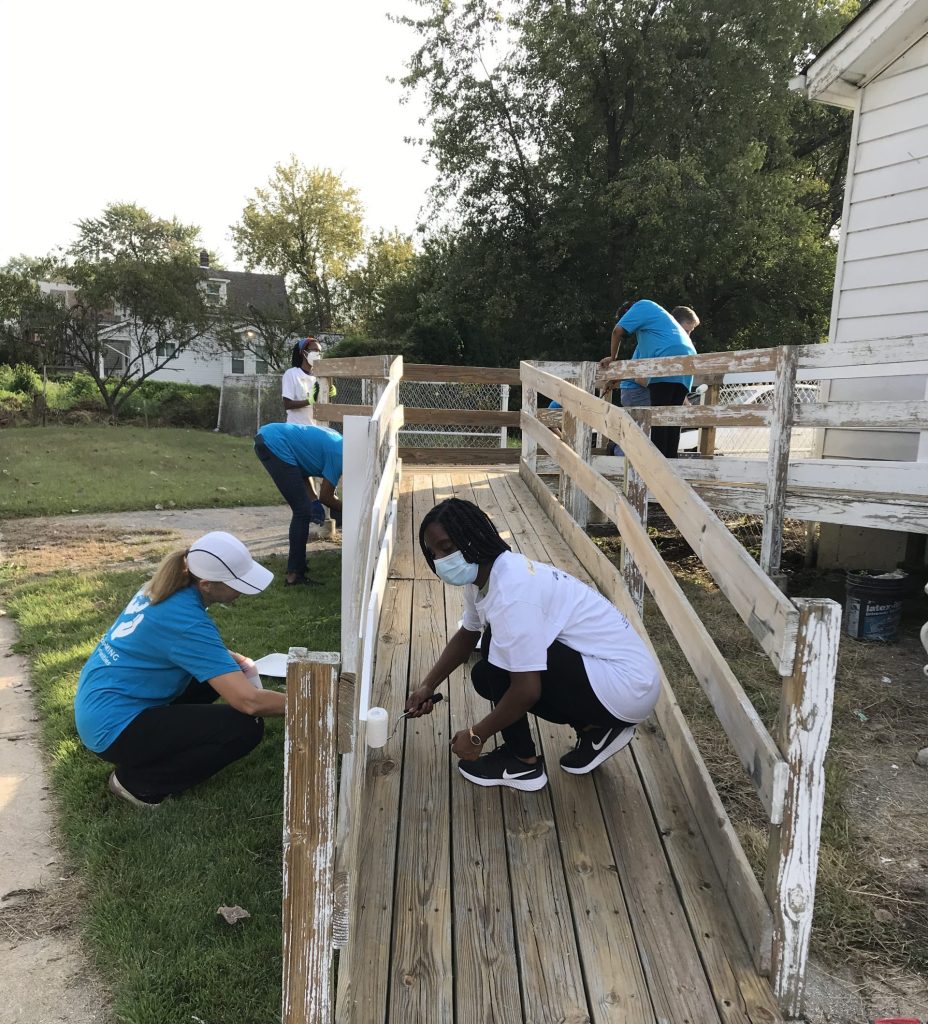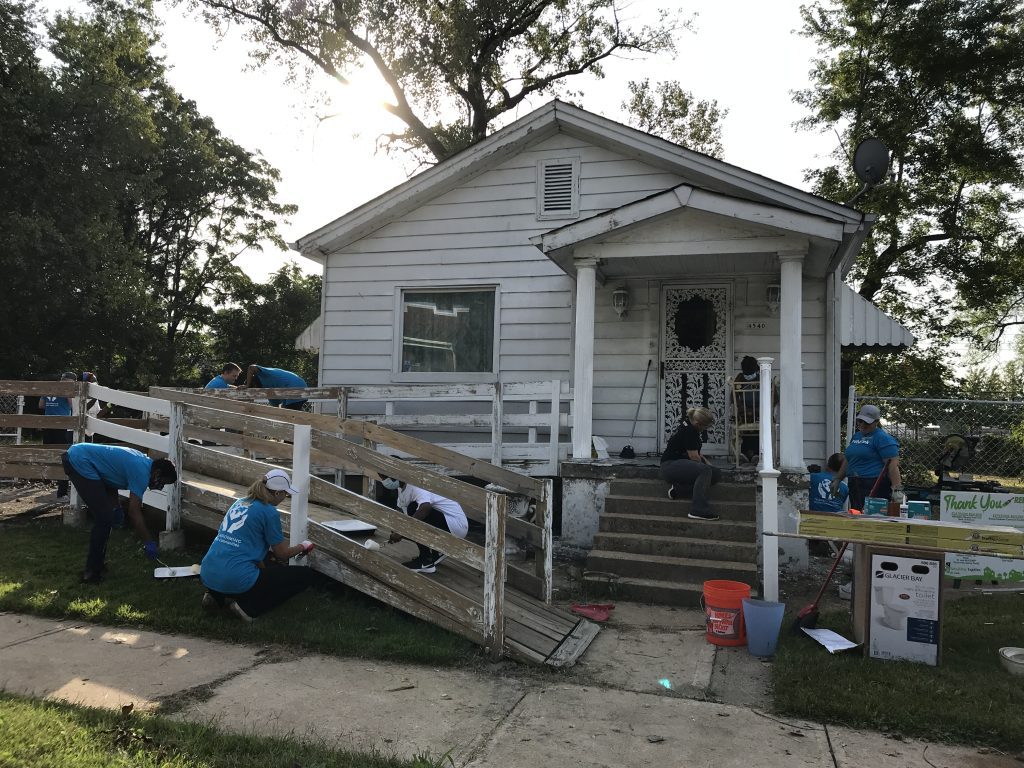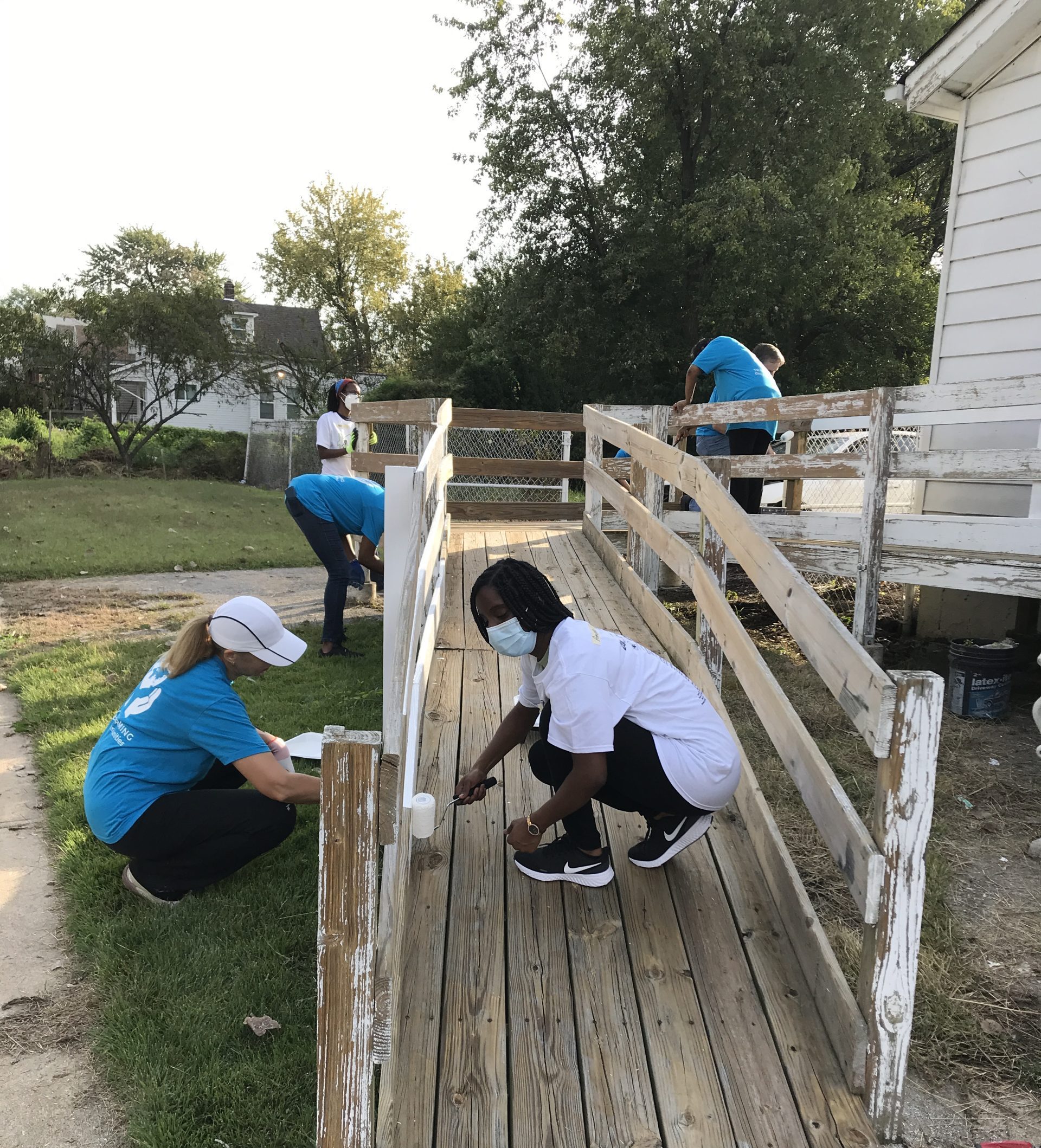
Rebuilding Together, a nonprofit that works in home repair, found that every dollar it spent on home repairs returned $2.84 in “social value.” Photo courtesy of Rebuilding Together St. Louis
“I could sleep now in the house without worrying about it burning down.” For one North St. Louis homeowner, life changed after she got some repair work done to her home. The home had had problems for as long as she’d owned it. When she moved in, “someone had taken [the] electrical box off the meter,” she says. “It was working, but it was working bad. I was hoping the house wouldn’t catch on fire. The electrical box kept going out in the inside and you could smell the wires burning.”
Fortunately, the homeowner, who spoke with us with the understanding of anonymity, was able to complete repairs through the city’s Healthy Home Repair Program. The repairs gave her something she’d been missing for too long: a good night’s rest. “I’m way more comfortable. I couldn’t sleep at night, because I was scared that it would be a fire or something.”
Our group, the Community Innovation and Action Center at the University of Missouri—St. Louis, completed a study of the need for, and effectiveness of, home repairs for older homeowners in St. Louis. This North St. Louis homeowner was one of multiple residents we interviewed about their experiences with subsidized home repairs. Like others hardest hit by this problem, she is an older Black woman, who lives in a neighborhood that is among the most disadvantaged in our sample. Overall, we found that unmet repair needs were highest in areas with the lowest incomes and home values, which were also inevitably those with the largest Black populations.
According to the National Fire Protection Association, electrical failures caused about 46,700 home fires each year from 2015 to 2019, leading to an average of 390 civilian deaths every year and $1.5 billion in annual property damage. But even if a fire never breaks out, living with the risk itself can profoundly impair a person’s quality of life. Few of us would rest easy at night knowing our houses could catch fire at any minute.
House fire risk is just one of the many life-threatening consequences of home deterioration. Indeed, our research reveals a public health catastrophe in the making. Our survey of 583 older homeowners in St. Louis found that the average cost of unmet home repairs was $13,023, with the cost of making all these repairs citywide totaling over $300 million. Many of the respondents’ homes were quite old, with an average age of 97 years. Almost two-thirds of the respondents had owned their home for 26 years or more. Many of the homeowners struggled with long-term illness, exacerbated by their unsafe homes, and the resulting heavy medical bills.
Homes in bad condition are a serious problem, and repair programs dramatically improve people’s lives. Yet this issue attracts little attention. Why? It’s partly because the need for home repair is difficult to measure and its consequences are largely invisible to the public. Additionally, those most affected have historically faced a unique degree of exclusion from home repair aid.
We have created a practical approach to producing evidence on home repair problems and costs in hopes that it will prove useful to advocates and nonprofits across the nation doing this work.
Housing Deterioration Is Often Overlooked
The language of “housing deterioration” may bring certain images to mind: a collapsing porch, a broken window, a roof with missing shingles. These are things you might see from your car while driving down the street. But you won’t see the problems lurking inside the home. You won’t see the child sickened by black mold or the elderly couple sweating and breathing hard with no AC during a heat wave.
Neither will the people who make policy. Before they can get behind a solution, they must first “see” the problem. Advocates push them to do so, often with evidence. For example, housing is considered unaffordable if it costs a household more than 30 percent of its income. Many studies document the high and rising rate of housing cost burdens. Data availability has also helped to keep public pressure up on issues like eviction, gentrification, segregation, and exclusionary zoning.
But problems like black mold and lacking AC are largely hidden from view as policy concerns. These problems are not only difficult to see from the car window; more importantly, they are difficult to measure. We don’t collect data on property conditions like we do on demographics. As we learned early in our research, there are no publicly available datasets that allow users to identify home repair needs or estimate costs at the city or neighborhood level. Until now, the only reliable way to get that information was to send a skilled inspector into every home, which is prohibitively expensive. Neither low-income homeowners nor the groups that serve and advocate for them can afford such expenses on their own.
If home dilapidation plagued more-privileged people, policymakers would likely be more willing to tackle it. Lower income people and Black and Hispanic households are more likely to be renters. These groups have long mobilized to fight slum housing conditions. But with few exceptions, federal policies—like the 1949 Housing Act—have prioritized demolition over repair of existing homes. Likewise, public programs to aid home repairs have been funded at low levels and some, like the Section 312 low-interest rehab loan program, have been discontinued. The Community Development Block Grant (CDBG), created in 1974, has not. According to an analysis of HUD data, about 25 percent of CDBG funding went to housing in 2011, with three-quarters of this going to home repairs. But we calculate that the value of CDBG funding has shrunk by about 75 percent between its peak in the late 1970s and 2019.
Meanwhile, repair funds have disproportionately benefited white, suburban homeowners. During suburbanization, policymakers sold homeownership to American citizens by insuring loans to lower the costs of both mortgage bills and “do-it-yourself” home improvement expenses. The latter policy, the Federal Housing Administration’s Title I program, surpassed the more well-known FHA mortgage insurance program in number of loans for decades. Not just a thing for extravagant “upgrades,” it funded repairs to fix the same kinds of problems that plague poorer households today. Today, the program tends to serve lower-income people. However, over the years, the program’s loan volume has plummeted, in part due to predatory scams and availability of private alternatives. Americans with higher incomes and good credit scores can go to a bank, take out one of these loans, and then head to Home Depot or hire repair professionals. But low-income borrowers, especially people of color, have been all but shut out of these options, with exceptionally high denial rates.
Despite these gaps, policymakers, when they talk about solving housing problems today, usually aren’t talking about home repair at all. Instead, they mean opening up access to homeownership for more people by offering new credit products or stimulating new construction.
These policy trends have profound and dire consequences. As our research shows, older, lower-income homeowners, especially Black women, are disproportionately burdened by housing deterioration.
How We Did it
Our study began with a group of advocates who were busy tackling a problem familiar to St. Louis: housing vacancy. The group, called the Vacancy Prevention Working Group of the St. Louis Vacancy Collaborative, came to researchers at the Community Innovation and Action Center at the University of Missouri-St. Louis with a two-part question: What causes housing vacancies? Is lack of aid for home repair a major factor? Our research team grew from that initial collaboration.
We found an inspiring example to follow in a study completed by the Federal Reserve Bank of Philadelphia and PolicyMap. Using American Housing Survey (AHS) data, the study estimated that nationwide, the cost of needed home repairs was $126.9 billion. We asked the Philadelphia team if they could estimate the need for home repairs in St. Louis, but limitations in the AHS data made that impossible. The AHS sample concentrates on large metropolitan areas, and the data does not enable researchers to drill down to the city or neighborhood level.
There was no getting around having to produce our own cost estimates. Building on the breakthrough Philadelphia study, we concluded that citywide home repair costs could be estimated based on people’s experiences of their homes. We designed our questionnaire to elicit data on specific repair “scenarios” that could subsequently be linked to specific cost data. We distributed our questionnaire to 2,500 older homeowners in St. Louis, receiving back 583 completed surveys. (Our questionnaire and a toolkit that enables any city to estimate the need for home repairs are available online here.)
Housing deterioration is not just about the physical structure; it is also about how people experience their home. We partnered with two nonprofits and the City of St. Louis Community Development Agency, using their records to identify older homeowners who’d had repairs done in the past two years to evaluate their experiences. We followed up with qualitative interviews with 31 of the 83 respondents. These accounts provide insights beyond what quantitative surveys are able to capture. They also narratively drive home the huge impact that housing deterioration has on people’s quality of life.

Rebuilding Together, a nonprofit dedicated to home repair, works on a house in St. Louis. Photo courtesy of Rebuilding Together St. Louis.
What We Found
Our findings revealed an immense, widespread backlog of repair need. The most commonly needed repairs were installation of electrical outlets and weatherization. Over 81 percent of our respondents reported using an electrical outlet for more than two electrical devices, a potential fire hazard. Temperature and air problems were also common, including faulty ACs, people feeling “uncomfortably warm” in the home, and air leakage through doors and windows. Another major problem area was excessive moisture. Many reported water leaks in their roofs and basements, and 40 percent identified major cracks in walls. Plumbing problems were also common, with 28 percent reporting a sewer backup and 38 percent leaking pipes. Excessive moisture in the home causes mold, which has been linked to serious health problems, such as asthma. Over 25 percent reported having areas of mold larger than an 8.5 by 11-inch sheet of paper.
Backlogged repair costs were much higher in North St. Louis, which is predominantly Black, than in whiter South St. Louis. In census tracts where the population is over 80 percent Black, the average cost of needed repairs was $17,919, compared to only $7,962 in census tracts that were less than 20 percent Black. In many North St. Louis neighborhoods, median home values are less than $75,000. Confined to these neighborhoods by past and present laws and policies, Black homeowners have little home equity they can tap into to fund repairs when the need inevitably arises.
Of our 83 respondents for the evaluation survey, over 85 percent were Black, nearly 83 percent were women, and nearly 80 percent made less than $25,000 a year. Only 11 percent had attained a college degree or higher. These facts tell the story: home repair programs are benefitting a population that is vulnerable in many ways. We often overlook this reality because we assume homeowners are well off.
The data also highlights the promise of repair programs for lower-income homeowners. Respondents were overwhelmingly upbeat. Two-thirds reported that the repairs left them feeling “much more positive” about the quality of their life. Many cited “accessibility,” which included modifications like grab bars and ramps, as the area where repairs had the most positive effect.
We also found a possible connection between home repairs and vacancy. Over 7 in 10 homeowners reported that, following the repair, they were now “a lot more likely” to stay in their homes. The repair programs also helped people financially. Over 78 percent of our respondents reported that their finances had become “a lot” or “somewhat” easier and 72 percent reported that their home was now “a lot” or “somewhat” more valuable as a financial asset to them and their family.
Home Repairs Work
Environmental justice and public health researchers have widely documented how health is affected by housing deterioration, including toxic air from dampness and mold, the strain of excessive heat, and the danger of electrical fires. Our research shows that home repairs can powerfully counter some of these health hazards. Weatherization, for example, is relatively inexpensive (costing, we estimate, on average $1,542). As we face increasingly brutal summers with life-threatening heat waves, weatherizing can make the home safer and more comfortable. Besides that, it can also reduce heating and air conditioning bills for financially stretched households, paying for itself in a relatively short time.
Likewise, research has shown that inexpensive modifications can prevent falls, one of the most serious health threats to older adults. Home repairs can also enable older Americans to remain in their homes, thereby avoiding the massive life disruptions that can come from displacement and housing instability.
[RELATED ARTICLE: Why Organizations Should Invest in Home Repairs to Improve Health]
The financial benefits of repair to homeowners are equally important. Even very low-income homeowners often have equity in their homes—though it is much less than high income homeowners. According to Harvard’s Joint Center for Housing Studies, in 2016, older adults with incomes below $15,000 had on average $80,000 in home equity, compared to only $9,000 in non-housing wealth. This equity is threatened when home repair needs are not addressed.
From a strictly economic standpoint, home repair is still worthwhile. Rebuilding Together, a national nonprofit specializing in home repair, commissioned a study of the costs and benefits of such programs. The study found that every dollar the nonprofit invested in repair work generated $2.84 in “social value.” Of that value, $1.32 came from saved expenses for Medicare and Medicaid, due to fewer falls and hospitalizations, fewer fire-related injuries, less exposure to lead, less stress and depression, and reduced use of assisted living facilities.
Policy Isn’t Working
Recently, leading policy voices have championed “supply-side progressivism,” that is, the idea of boosting affordable housing supply by passing more permissive zoning policies and radically expanding new construction. Despite its merits, this approach overlooks the pressing need for home repairs. Especially in less hot markets—but arguably elsewhere too—it makes sense to allocate funds toward purchasing and fixing up older housing at a lower cost per new affordable unit. The status quo, however, is still one in which policymakers expect housing to “filter down”: that is, to let older housing deteriorate to the point that it is “affordable.” The chickens of this approach are coming home to roost: Each year, hundreds of thousands of homes are lost to vacancy and abandonment and too many people live in homes that are a threat to their health and even their lives.
Our findings attest to the reality that housing deterioration is a long-term, chronic condition. Concentrating housing investment in hot market neighborhoods contributes to the spatial inequality and disinvestment that drives housing deterioration. The two issues are linked and should be considered together. The same is true for affordability. If a household pays less than 30 percent of its income on housing, but the home is unsafe and insecure, that is hardly a good example of affordable housing. Without taking into account housing deterioration, we are significantly understating the affordability problem.
What We Can Do
Home repair programs are an effective way to preserve affordable housing and keep it safe and secure. Making home repair visible as a policy issue also means ensuring that policymakers understand that it’s not just about fixing up homes. It’s about repairing society by fighting legacies of race and class discrimination that have devastated many of our communities. The 1948 United Nations Universal Declaration of Human Rights, which the United States signed on to, declared that housing is a human right. Housing provision must be “adequate,” meeting basic standards of habitability. When housing deteriorates, leading to a multitude of negative effects, it violates that basic right.
The scale of that violation affects not just people but entire communities. Disparities in housing deterioration and repair, like those we found in St. Louis, create stark environmental injustices and exacerbate the racial wealth gap.
In light of these issues, we need new public programs for home repairs, such as Pennsylvania’s recent $125 million commitment. These should include enhanced home repair loan programs as well as grants. Some cities have borrowed money on the bond market to fund repairs. In Philadelphia, a home repair bond was made possible by an increase in the realty transfer tax. Advocates have also found success forming provider networks, such as the Home Repair Network (HRN) in St. Louis, which our research helped to jump-start. HRN has developed a home repair reform agenda that includes centralized intake for all home repair applicants, coordinating repairs with other social services, and supporting job training and business development programs to build out capacity to ramp up home repair programs and shorten waiting lists.
[RELATED ARTICLE: Sealing the Cracks in Weatherization and Home Repair]
Ultimately, when affluent communities hoard housing investments, other communities suffer. Housing deterioration is a story of racial, economic, and environmental injustice. And as our research shows, repair programs work. Let’s spread the word.






Comments